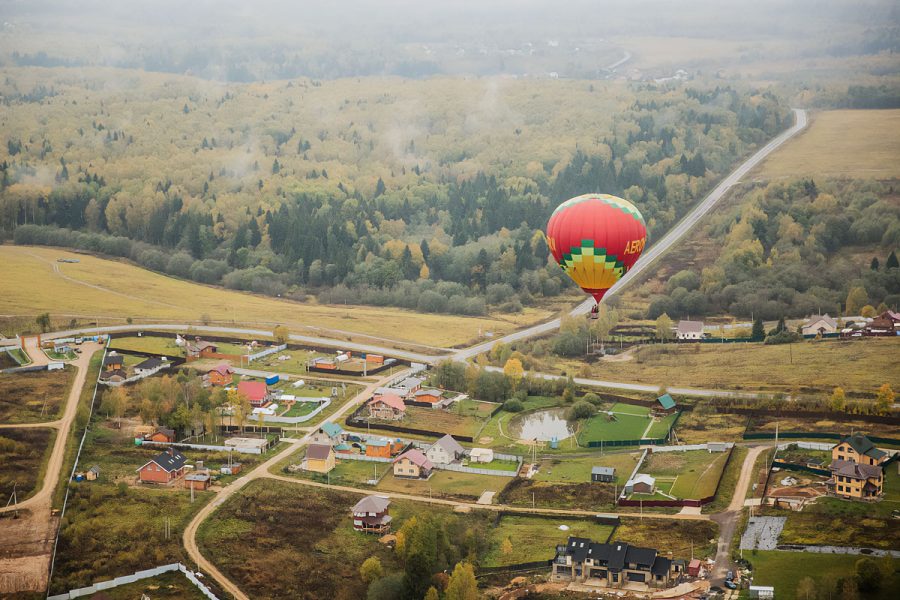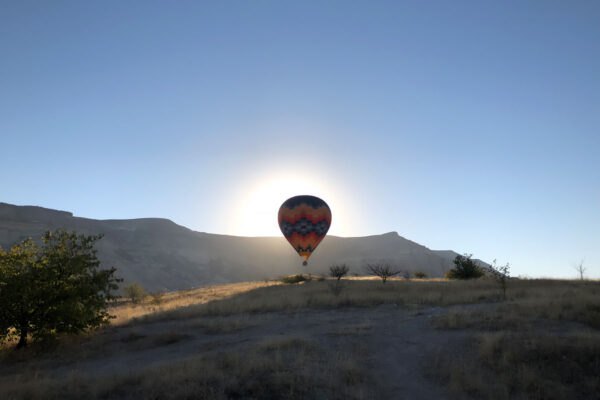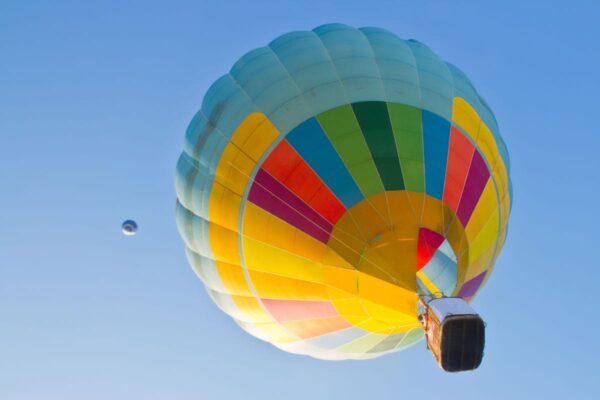Aballoon flight is an extraordinary experience that allows you to see the world from a completely new perspective. Hovering high above the ground gives you a sense of freedom and peace that is difficult to experience in everyday life. However, not everyone can safely participate in such an adventure. The health of passengers is a priority for pilots and organizers of balloon flights.
During a balloon flight, the human body is exposed to various factors that can affect well-being. Changes in altitude, fluctuations in atmospheric pressure or air temperature all affect the functioning of the human body. People with certain medical conditions or in certain physiological states may experience discomfort or even compromise their health during such a trip.
Companies that organize balloon flights impose health restrictions to ensure the safety of all participants. These requirements are not an invention of the organizers, but are based on medical research and experience from flights at various altitudes. Knowing the health contraindications before booking a balloon flight helps avoid disappointment and potential health problems.
Before deciding to take a balloon flight, it’s a good idea to familiarize yourself with health restrictions and consult your doctor, especially if you have existing medical conditions. A responsible approach to health issues will ensure that the sky adventure is safe and full of positive experiences.
Who should not fly in a balloon due to health conditions
Balloon flight is an activity that requires a good physical and health condition. Certain medical conditions or conditions may contraindicate participation in such an adventure.
Cardiovascular diseases
People suffering from cardiovascular conditions should exercise extreme caution. Changes in atmospheric pressure during ascent can put undue stress on the cardiovascular system. Patients with uncompensated heart failure, after a recent heart attack, or with severe hypertension should not take the risk of balloon flight.
Medications used to treat cardiovascular disease, such as anticoagulants or cholesterol-lowering agents, can increase the risk of complications during the flight. People taking such medications should consult a doctor before planning a balloon ride.
Stable coronary artery disease under medical control does not always preclude flight, but requires individual medical evaluation. The patient’s condition and the severity of the disease are crucial.
Pregnancy
Pregnant women should not participate in balloon flights. Pregnancy is a period of physiological and hormonal changes that can affect the body’s ability to handle the stresses of flight.
Reasons to exclude pregnant women from balloon flights:
- Risk of abrupt landing, which can be dangerous for both mother and child
- Changes in atmospheric pressure that can adversely affect the health of the woman and the fetus
- Limited space in the balloon basket making it difficult to take a safe position
- Lack of rapid medical evacuation in case of sudden pregnancy complications
Even in the case of early pregnancy, when the woman feels well, it is advisable to forgo the balloon flight for safety.
Respiratory conditions
Asthma and other chronic lung diseases may contraindicate balloon flights. Changes in atmospheric pressure affect the respiratory system and can cause discomfort or difficulty in breathing for those with lung problems.
The presence of allergens in the air, such as pollen or mold spores, can trigger asthma symptoms and make the flight unpleasant or even dangerous. People with asthma should consult a doctor and get the necessary medication before deciding to take a balloon flight.
Fear of heights and anxiety disorders
People suffering from acrophobia (fear of heights) or other anxiety disorders may experience severe mental discomfort during a balloon flight. Being hundreds of meters above the ground in a small and enclosed basket can be stressful for people with such phobias.
Tip: Before booking a balloon flight, it’s a good idea to have a frank discussion with your health care provider about your existing medical conditions. A specialist will help assess whether your health condition allows you to safely participate in such an adventure.
The effect of altitude on the body during a balloon flight
The altitude at which a balloon flight takes place has a significant impact on the functioning of the human body. Understanding the physiological changes taking place helps to better prepare for the sky adventure.
Changes in the respiratory system
At higher altitudes, atmospheric pressure decreases, leading to a reduction in the amount of oxygen available to the body. Commercial balloons usually do not ascend above 3,000 meters, but even at this altitude the first symptoms of hypoxia can occur.
The body responds to the reduced amount of oxygen by increasing the frequency and depth of breathing. This natural response, called hyperventilation, is designed to deliver more oxygen to the lungs. In most healthy individuals, this mechanism effectively compensates for oxygen deficiency at moderate altitudes.
With rapid balloon ascent, the respiratory system may not be able to keep up with the adaptation, leading to a feeling of shortness of breath or mild dizziness. These symptoms usually subside after a few minutes as the body adapts to the new conditions.
Cardiovascular responses
The heart responds to reduced oxygen by speeding up its heart rate. The increased frequency of the heart’s contractions is designed to deliver more blood, and thus oxygen, to all the body’s tissues.
The heart’s stroke volume decreases slightly, and bodily functions not directly related to survival are reduced. Among other things, this leads to a decrease in the efficiency of food digestion.
Physiological changes during flight at different altitudes:
- 1000-2000 m: Minimal changes in respiratory rate and heart rate
- 2000-3000 m: Noticeable acceleration of breathing and heart rate, possible slight dizziness
- Above 3000 m: Significant acceleration of breathing and heart rate, possible symptoms of altitude sickness
Full acclimatization of the body to altitude conditions takes time. During a short balloon flight, usually lasting 1-2 hours, the body will not have time to fully adapt to the changed conditions.
The first stage of adaptation is an increase in respiratory rate, which leads to greater excretion of carbon dioxide and respiratory alkalosis. Gradually, the body compensates for this condition by excreting bicarbonate through the kidneys.
In the long term, there is an increase in the production of red blood cells, an increase in the concentration of hemoglobin and other physiological changes, which, however, are not significant during a standard balloon flight.
Effects on cognitive function
Even moderate oxygen deprivation can affect cognitive function. Studies have shown that already at an altitude of about 3,000 meters, a reduced ability to learn new tasks can be observed.
During a balloon flight, passengers may experience mild euphoria, dizziness or slowed reactions. These symptoms are usually mild and do not significantly affect the comfort of the flight, but may be more severe in people with existing medical conditions.
Tip: It’s a good idea to drink plenty of water when flying in a balloon, as the body dehydrates faster at higher altitudes due to dry air and increased breathing rate. Avoiding alcohol before the flight also helps the body cope better with altitude changes.
Medical recommendations before booking a balloon flight
Adequate medical preparation before a balloon flight increases the safety and comfort of the trip. By following a few key recommendations, you can avoid unpleasant surprises during the flight.
Consultation with a doctor
People with chronic medical conditions should consult a doctor before planning a balloon flight. A specialist will help assess whether your health condition allows you to safely participate in such an activity.
During the medical visit, it is a good idea to discuss the nature of the balloon flight, including the expected altitude, duration and conditions in the basket. Such information will help the doctor make more precise recommendations.
Patients taking medications on a regular basis should ask about the possible need to modify their dosage before the flight. Some medications may interact with changes in atmospheric pressure or affect the body’s ability to adapt to altitude conditions.
Check-ups
Before booking a balloon flight, it’s a good idea to perform basic check-ups, especially if it’s been a long time since your last visit to the doctor. A blood pressure measurement, ECG or spirometry can provide important information about your health.
People over the age of 40, even without diagnosed diseases, should consider preventive tests before flying. As we age, the risk of unrecognized cardiovascular conditions increases, which can become apparent under the stress of flight.
Recommended pre-flight balloon tests:
- Measurement of blood pressure
- ECG examination (especially for those over 40)
- Basic blood tests
- Spirometry (for those with respiratory problems)
- Ophthalmic consultation (for those with eye diseases)
People who regularly take medications should take them with them on the balloon flight. This is especially true for medications taken at regular times and rescue preparations, such as inhalers for asthmatics.
Pack the medications in an easily accessible place, preferably in a small bag or pouch that you can carry with you during the flight. It is also a good idea to inform the pilot of medical conditions that require emergency medical intervention.
Do not take new medications that are unfamiliar to the body before the flight, as they can cause unforeseen reactions in the changed weather conditions.
Rest and hydration
Adequate rest and hydration is recommended before a balloon flight. Fatigue and dehydration can exacerbate the body’s negative reactions to changes in altitude and pressure.
The night before the flight should be devoted to a restful sleep, without alcohol or hard-to-digest meals. Alcohol can exacerbate dehydration and interfere with the body’s ability to adapt to altitude conditions.
On the day of the flight, it is a good idea to drink plenty of water, while avoiding caffeinated beverages, which have a diuretic effect and can contribute to dehydration.
Tip: People who wear glasses or contact lenses should bring a spare pair of glasses with them. Dry eyes can occur at altitude, which can cause discomfort when wearing contact lenses.
Professional balloon flights with ProBallooning
ProBallooning is a company specializing in organizing professional balloon flights that combines a passion for ballooning with the highest safety standards.
ProBallooning Company
ProBallooning was founded by an experienced pilot with more than eight years of ballooning experience. The company’s founder has about 500 flights to his credit, which translates into a wealth of experience in operating balloons in various weather conditions.
The company’s history began with sport flying, which is the typical path for most balloon pilots. The founder of ProBallooning is not only a commercial pilot, but also an active competitor of the Polish National Team in gas balloon flying and a member of the Leszczynski Balloon Club.
The company regularly participates in events of the rank of Polish Cup and World Championships, which proves the high level of skill and professionalism. The main goal of ProBallooning is to promote ballooning in Poland and enable as many people as possible to experience this extraordinary adventure.
The ProBallooning team also includes Aline, a pilot originally from Brazil, for whom ballooning is a family tradition. Her parents have 30 years of experience in flying and making balloons, and they have also passed on the passion for the sport to her brothers, who are also pilots.
Balloon flights offered
ProBallooning offers a variety of customized balloon flight packages. All flights are carried out with the utmost attention to passenger safety and comfort.
The company specializes in sightseeing flights, which allow you to admire the picturesque landscapes of Mazovia from a bird’s eye view. During the flight, you can enjoy a panoramic view including the Vistula and Pilica rivers, the Bolimowski Landscape Park and other attractions of the region.
Types of flights offered by ProBallooning:
Each flight is organized in small groups, ensuring a window seat and a full experience for all participants. Flights take place in the scenic areas of Warsaw, Radom and Lodz, offering unique views of local attractions.
Safety during flights is a top priority for ProBallooning. Balloons are regularly inspected and maintained in perfect working order, ensuring a peaceful and safe flight.
The company employs experienced pilots with air carrier certificates, who guarantee not only safety, but also a full flight experience in the sky. Each flight is preceded by a thorough analysis of weather conditions.
ProBallooning also cares about passenger comfort, providing professional service before, during and after the flight. The company offers flexible flight timings to suit customer preferences and weather conditions.
Customer reviews
ProBallooning’s customers speak highly of the professionalism and commitment of the crew. Reviews often praise the safety of flights, friendly atmosphere and unforgettable experience.
Passengers appreciate the individual approach to each customer and the attention to detail that makes a balloon flight a unique experience. Particularly positive reviews apply to engagement and private flights, which create a magical atmosphere for special occasions.
The company enjoys an excellent reputation among ballooning enthusiasts, and many customers return to use its services again. This demonstrates the high level of satisfaction and trust that ProBallooning enjoys.
Tip: When planning a balloon flight with ProBallooning, it’s a good idea to book a date in advance, especially during the summer season, when demand for flights is highest. The company offers the opportunity to purchase gift vouchers that have a long expiration date, allowing for flexibility in planning the adventure.
How changes in atmospheric pressure affect balloon passengers
Changes in atmospheric pressure during a balloon flight can affect the human body in various ways. Understanding these mechanisms allows you to better prepare for your sky adventure.
The physics of pressure changes
Atmospheric pressure decreases with increasing altitude. At sea level it is about 1013 hPa, but already at an altitude of 1,000 meters it drops to about 900 hPa. This change affects the behavior of gases in the human body.
With an increase in altitude of about 8 meters, atmospheric pressure drops by 1 hPa. Commercial balloons usually reach an altitude of 1000-3000 meters, which means a pressure drop of 100-300 hPa compared to sea level.
Pressure changes during balloon flight are usually slow and gentle, allowing the body to gradually adapt to the new conditions. This is a significant difference from the rapid pressure changes during airplane flight.
Effects on ears and sinuses
One of the most common effects of pressure changes is the feeling of clogged ears. This is due to the pressure difference between the external environment and the middle ear, which is connected to the throat via the Eustachian tube.
During the ascent of the balloon, the air pressure in the middle ear is higher than the external pressure, which pushes the eardrum outward. When descending, the situation is reversed – the eardrum is pushed inward.
Methods of equalizing pressure in the ears:
- Swallowing saliva
- Chewing gum
- Yawning
- Valsalva maneuver (gently blowing air with mouth and nose closed)
- Toynbee maneuver (swallowing with mouth and nose closed)
People with upper respiratory infections, allergic rhinitis or chronic sinusitis may have difficulty equalizing pressure in the ears and sinuses, which can lead to pain and discomfort during the flight.
Expansion of gases in the body
According to Boyle-Mariotte’s law, the volume of a gas is inversely proportional to the pressure, at a constant temperature. This means that when the pressure drops, the gases in the closed spaces of the body expand.
Gases trapped in body cavities, such as the intestines, sinuses or cavity teeth, can increase in volume as the balloon rises. This can lead to a feeling of bloating, abdominal pain or increased toothache.
People who have recently undergone abdominal or thoracic surgeries should consult a doctor before flying the balloon, as the expanding gases can cause discomfort or even health complications.
Effects on the cardiovascular system
Changes in atmospheric pressure also affect the cardiovascular system. Lower pressure at higher altitudes causes blood vessels to dilate, which can lead to a drop in blood pressure.
The body compensates for this effect by speeding up the heart rate and increasing the force of contraction of the heart muscle. In healthy individuals, these mechanisms effectively maintain normal blood pressure, but in people with cardiovascular disease, they may be insufficient.
People with unstable hypertension may experience pressure fluctuations during balloon flights, which can lead to dizziness, headache or general weakness.
Note: People with ear or sinus disease or recent dental surgery should inform the flight organizer. The pilot can then plan a gentler ascent and descent, minimizing discomfort from pressure changes.
Safety of the elderly and pregnant women during balloon flights
Special groups of passengers, such as the elderly and pregnant women, require extra attention in terms of safety during balloon flights.
The elderly and balloon flights
Age in itself is not a contraindication to balloon flights. Many elderly people can safely and comfortably participate in such an adventure, enjoying unforgettable aerial views.
The key factor is general health and physical fitness. The elderly should be able to climb into the basket of the balloon, which is about 1.1-1.2 meters high, on their own. This requires some fitness and strength in the legs.
During the flight, passengers must stand for about an hour, which can be a challenge for people with joint problems or muscle weakness. In addition, when landing, it is necessary to assume a position with knees bent to cushion any impact.
Physical requirements for balloon passengers:
- Ability to climb into the balloon basket on their own (height of about 1.1-1.2 meters)
- Ability to stand unsupported for about an hour
- Ability to assume a position with knees bent during landing
- No serious problems with knees, hips or spine
- Height of more than 120-140 cm (depending on the company)
Older people with chronic diseases such as diabetes, hypertension or heart disease should consult a doctor before flying. The doctor can assess individual risk and make recommendations for safe participation in the flight.
Contraindications for pregnant women
Pregnancy is an absolute contraindication to balloon flights. All companies that organize balloon flights refuse to take pregnant women on board, regardless of the stage of pregnancy or the well-being of the mother-to-be.
The main reason is the risks associated with landing a balloon, which can be violent and unpredictable. Even with a smooth landing, there are forces that can be dangerous to a developing fetus.
Changes in atmospheric pressure during flight can also adversely affect placental blood flow, which can lead to fetal hypoxia. Studies have shown that prolonged exposure to high altitudes can cause intrauterine growth restriction and increase the risk of preeclampsia.
Women who are planning a pregnancy or suspect they may be pregnant should also consider forgoing a balloon flight. The safety of the mother-to-be and the baby should always be a priority.
Limitations for people with disabilities
People with disabilities may face additional challenges with balloon flights. Companies that organize such flights try to allow people with various limitations to participate, but there are some objective barriers.
People in wheelchairs usually cannot participate in balloon flights. Balloon baskets are not designed to carry wheelchairs, and their design makes it impossible to safely place a disabled person on board.
Similarly, people who use canes, crutches or balconies may have difficulty safely participating in the flight. These items cannot be taken on board, as they cannot be securely fastened, and could pose a danger to all passengers during landing.
Recommendations for the elderly
Elderly people planning a balloon flight should take several preparatory steps to ensure their safety and comfort during this adventure.
Before booking a flight, it’s a good idea to have a check-up with a doctor to assess your overall health and fitness. Special attention should be paid to the condition of the cardiovascular system, respiratory system and musculoskeletal system.
On the day of the flight, it is advisable to wear comfortable athletic shoes with non-slip soles to ensure stability when entering the basket and during landing. Clothing should be layered, as the temperature at altitude may be lower than on the ground.
Tip: Older people should inform the pilot of their physical limitations before flying. An experienced pilot can adjust instructions and help them safely enter the basket and assume the proper position during landing.
Summary
Balloon flying is a fascinating adventure that allows you to see the world from a whole new perspective. However, not everyone can safely participate in such an activity. Health restrictions for balloon passengers are due to concerns for the safety of all participants in the flight.
People with cardiovascular diseases, respiratory problems, pregnant women and those suffering from fear of heights should be especially careful about planning a balloon flight. In many cases, these conditions are an absolute contraindication to participating in such an adventure.
The effects of altitude on the human body are significant. Reduced oxygen partial pressure, gas expansion in body cavities and changes in cardiovascular function are just some of the physiological reactions to balloon flight. Healthy people usually tolerate these changes well, but for those with existing medical conditions they can be a serious burden.
It’s a good idea to consult a doctor before booking a balloon flight, especially if you have a chronic condition. Performing basic check-ups can help you assess the risks and make an informed decision. Proper preparation, including rest and hydration, increases comfort and safety during the flight.
Companies such as ProBallooning offer professional balloon flights with the highest level of safety. Experienced pilots, regularly serviced equipment and an individual approach to each customer make the ballooning adventure an unforgettable experience.
Changes in atmospheric pressure during flight can cause discomfort, especially in the ears and sinuses. Knowledge of pressure equalization techniques helps alleviate these symptoms. People with upper respiratory infections should consider postponing the flight.
Special attention should be paid to the safety of the elderly, who must meet certain physical requirements to participate in a balloon flight. Pregnant women should refrain from this activity altogether due to the risk to the developing fetus.
Awareness of health limitations and proper preparation allow you to enjoy the beauty of balloon flight without compromising your health. Safety should always be a priority, and the sky adventure should remain in the memory as a positive and enriching experience.





